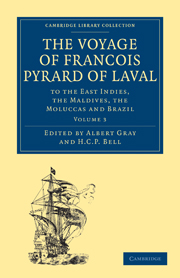Book contents
- Frontmatter
- Contents
- ADDENDA ET CORRIGENDA
- HEADINGS OF CHAPTERS
- VOYAGE: PART THE SECOND (continued)
- TREATISE OF ANIMALS, TREES, AND FRUITS
- ADVICE FOR THE VOYAGE TO THE EAST INDIES
- DICTIONARY OF SOME WORDS OF THE MALDIVE LANGUAGE
- APPENDIX
- A Early Notices of the Maldives
- B Notices of the Exiled Kings of the Maldives
- C The History of Kunháli, the Great Malabar Corsair
- D List of Kings of the Maldive Islands since the Conversion to Mahomedanism
- E Dedicatory Epistle to M. Guillaume
- GENERAL INDEX
- Plate section
C - The History of Kunháli, the Great Malabar Corsair
Published online by Cambridge University Press: 04 April 2011
- Frontmatter
- Contents
- ADDENDA ET CORRIGENDA
- HEADINGS OF CHAPTERS
- VOYAGE: PART THE SECOND (continued)
- TREATISE OF ANIMALS, TREES, AND FRUITS
- ADVICE FOR THE VOYAGE TO THE EAST INDIES
- DICTIONARY OF SOME WORDS OF THE MALDIVE LANGUAGE
- APPENDIX
- A Early Notices of the Maldives
- B Notices of the Exiled Kings of the Maldives
- C The History of Kunháli, the Great Malabar Corsair
- D List of Kings of the Maldive Islands since the Conversion to Mahomedanism
- E Dedicatory Epistle to M. Guillaume
- GENERAL INDEX
- Plate section
Summary
Although the story of Kunháli, as shortly given by Pyrard, is generally accurate, it differs in some respects from the fuller account given by the official historian, De Couto, and from that of Faria y Souza, and, as will naturally happen when a narrative is compiled from the reminiscences of casual informants, the dates are sometimes wrong. The detail in which De Couto recounts the operations against the great corsair attests the importance attributed by the Portuguese to the reduction of the fortress, and Pyrard's episodical account, in like manner, shows how the story of the brave Kunháli was in everyone's mouth, and how, with all his cruelties and robberies, he had achieved the posthumous fame of a hero. It may be advisable, therefore, to supplement the traveller's narrative with a résumé of this episode in Portuguese-Indian history, so far as it can be traced in the writings of the time.
During the viceroyalty of Dom Antonio de Noronha (1571-3) Kunháli the elder (uncle of the great corsair), who was then a native of Kurichchi, cast his eyes upon the neighbouring port of Putu pattanam as a place well adapted for a rover's stronghold. The permission of the Samorin was obtained, and Kunháli, with his kindred and associates, proceeded to build the fortress, afterwards known as “Kunháli's fort”, and, according to Pyrard, Marcaire costè (Márakkár Kóttá.)
- Type
- Chapter
- Information
- The Voyage of François Pyrard of Laval to the East Indies, the Maldives, the Moluccas and Brazil , pp. 509 - 527Publisher: Cambridge University PressPrint publication year: 2010First published in: 1890



